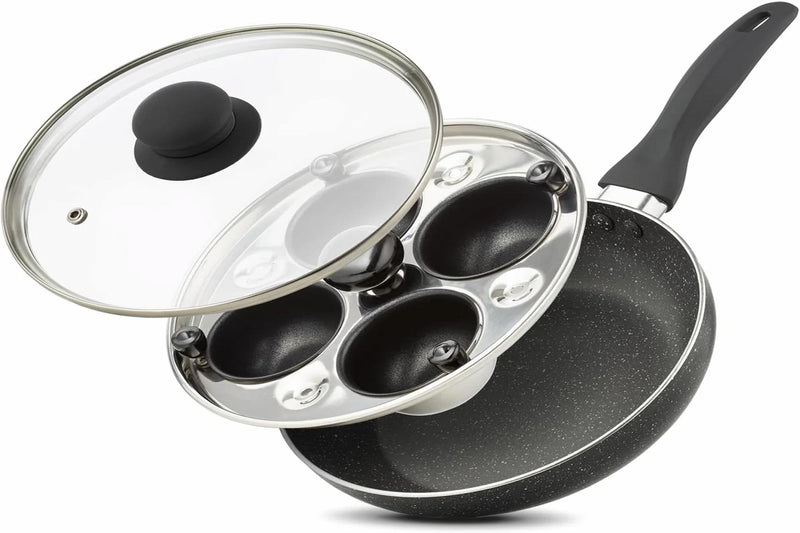
Poached eggs have long been celebrated as a breakfast staple—delicately cooked, with tender whites and luscious yolks. But when it comes to preparing these breakfast gems, home cooks often face a dilemma: Should they stick to traditional methods or upgrade to a specialized egg poacher pan? In this article, we’ll dive into both approaches, comparing their advantages and challenges, and help you decide which fits best in your kitchen.
Understanding Poached Eggs and Their Appeal
Why Poached Eggs Are a Breakfast Favorite
Poached eggs offer a light, healthy alternative to fried or scrambled eggs. Without added fats or oils, they’re perfect for those seeking a clean, nutritious start to their day. Their silky texture pairs wonderfully with toast, salads, and breakfast bowls, making them a versatile morning favorite.
The Perfect Texture and Taste of Poached Eggs
A perfectly poached egg boasts a tender, just-set white, wrapping a warm, runny yolk. The balance between firmness and creaminess defines its appeal—an experience that transforms any dish from ordinary to gourmet.
Traditional Methods of Poaching Eggs
The Classic Water Bath Technique
Traditional poaching involves simmering eggs in gently swirling water. The water bath method is simple: crack the egg into a small bowl, then slide it into barely simmering water. Cooking times range from 3 to 5 minutes, depending on desired yolk firmness.
Vinegar in Water: Does It Really Help?
Many cooks add vinegar to the poaching water, believing it helps the egg white coagulate faster. While vinegar can firm the whites slightly, it also imparts a subtle tang if used in excess. Whether to use vinegar depends on your taste preference and cooking style.
Common Issues: Broken Yolks and Runny Whites
Despite its popularity, the traditional technique can be tricky. Eggs can easily break apart in the water, resulting in shredded whites and uneven cooking. Achieving the ideal shape and texture requires practice and patience.
Modern Method: Using an Egg Poacher Pan
What is an Egg Poacher Pan?
An egg poacher pan is a specially designed cookware piece featuring individual cups or compartments to hold eggs while cooking. These pans often come with a lid to trap steam, ensuring gentle and uniform heat around the eggs for consistent results.
How to Use an Egg Poacher Pan for Perfect Results
To poach eggs in a pan, lightly grease each cup, crack eggs into the compartments, then cover and cook on simmering water or directly on a stove burner (depending on the design). Within minutes, you get perfectly shaped poached eggs with minimal effort.
Advantages of Using an Egg Poacher Pan
Egg poacher pans offer several benefits:
-
Controlled cooking environment reduces risk of broken eggs.
-
Uniform heat distribution yields consistent texture.
-
Easy to monitor and remove eggs without breaking yolks.
-
Ideal for making multiple poached eggs simultaneously.
Egg Poacher Pan vs. Traditional Poaching: Side-by-Side Comparison
Time Efficiency: Which One is Quicker?
The egg poacher pan usually wins on speed. It allows multiple eggs to cook simultaneously without the need for swirling water or constant attention, speeding up breakfast prep.
Consistency in Cooking: Perfect Poach Every Time
Egg poacher pans provide more consistent results. The cups hold eggs intact, preventing whites from dispersing, which often happens in the traditional water bath method.
Ease of Cleanup: Minimal Effort Required
Traditional poaching requires cleaning pots and dealing with stuck egg bits in water. Poacher pans, especially those with non-stick surfaces, make cleanup straightforward and hassle-free.
Flavor and Texture Differences
Some purists argue that eggs poached traditionally have a slightly more delicate texture due to direct water contact, while eggs from poacher pans may have firmer whites due to the contained cooking space. Both methods, however, produce delicious eggs when done properly.
Choosing the Right Method for Your Kitchen
When to Choose Traditional Poaching
Traditional poaching is ideal for those who enjoy culinary technique and don’t mind a bit of trial and error. It requires minimal tools and is perfect if you only poach eggs occasionally.
When an Egg Poacher Pan is the Better Option
If you value consistency, speed, and ease—especially when cooking multiple eggs—an egg poacher pan is the clear choice. It’s especially helpful for busy mornings or when cooking for a crowd.
How to Get Perfect Poached Eggs Every Time
Pro Tips for Traditional Poaching Success
-
Use fresh eggs for better whites that hold together.
-
Create a gentle whirlpool to help whites wrap around yolks.
-
Keep water at a gentle simmer, not a rolling boil.
-
Use vinegar sparingly to help coagulation without flavor overpowering.
Secrets to Using an Egg Poacher Pan Efficiently
-
Lightly grease each cup with oil or butter to prevent sticking.
-
Preheat the pan for even cooking.
-
Cover with a lid to trap steam and cook eggs evenly.
-
Monitor cooking time closely to avoid overcooking.
Why Eggssentials' Egg Poacher Pan Stands Out
High-Quality Materials for Better Cooking
Eggssentials’ poacher pans use premium materials that distribute heat evenly, ensuring perfectly cooked eggs every time.
Non-Stick Surface and Easy Cleanup
Designed with a durable non-stick coating, Eggssentials pans minimize sticking and simplify cleanup — a must-have for busy kitchens.
Perfect Poached Eggs Every Time
With Eggssentials’ precise design, you can achieve consistent, restaurant-quality poached eggs without stress or mess.
Final Verdict: Egg Poacher Pan or Traditional Method?
Which One Wins for Taste, Convenience, and Ease?
While traditional methods offer a classic touch and slightly delicate texture, the egg poacher pan wins for convenience, consistency, and ease of use. For anyone serious about perfect poached eggs with minimal fuss, Eggssentials’ poacher pan is the modern kitchen essential that truly delivers.
Ready to revolutionize your breakfast routine? Discover Eggssentials' egg poacher pans and enjoy effortless, delicious poached eggs every time!
